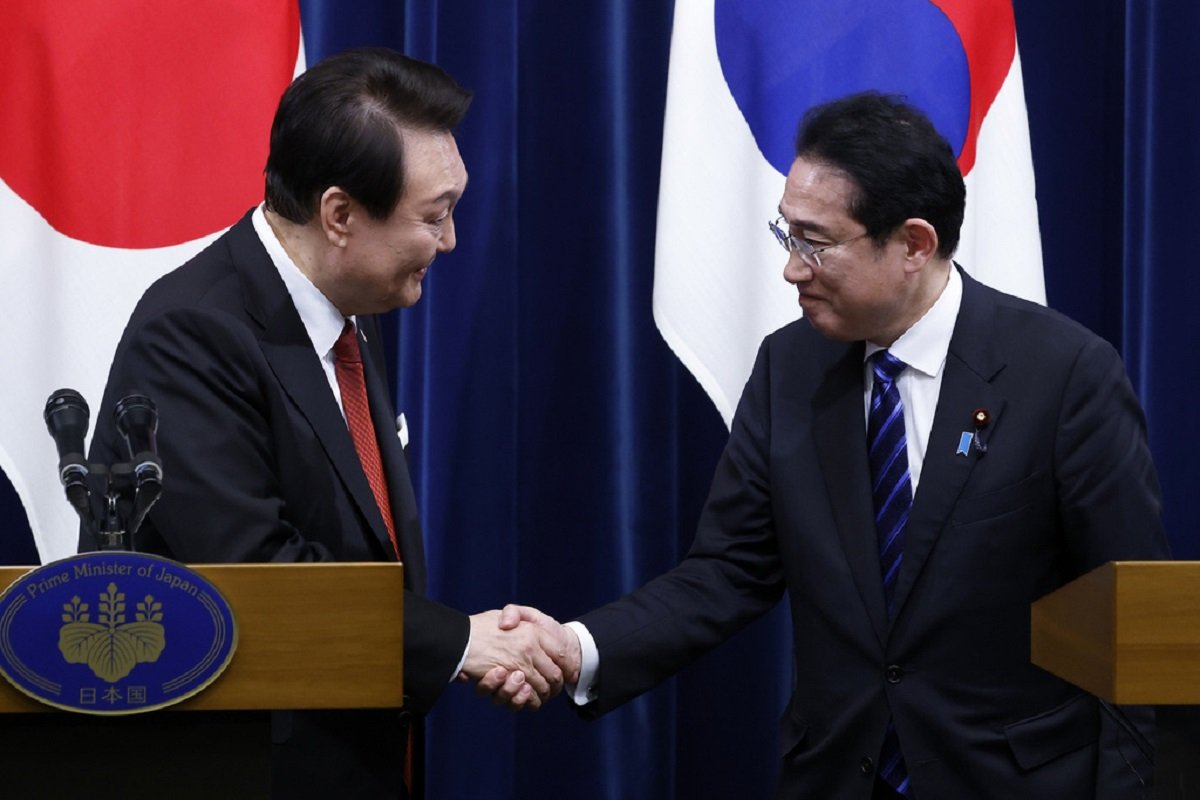
South Korean President Yoon Suk Yeol, left, and Japanese Prime Minister Fumio Kishida, right, shake hands following a joint news conference at the prime minister’s official residence in Tokyo, Japan, Thursday, March 16, 2023.
11:18 JST, March 18, 2023
SEOUL, South Korea (AP) — North Korea said Friday it fired an intercontinental ballistic missile to “strike fear into the enemies” as South Korea and Japan agreed at a summit to work closely on regional security with the United States and staged military exercises around the region.
The missile, launched Thursday from North Korea’s main airport as leader Kim Jong Un and his daughter smiled from afar, overshadowed a summit held hours later between South Korean President Yoon Suk Yeol and Japanese Prime Minster Fumio Kishida. The meeting in Tokyo was partially aimed at rebuilding security ties between the often-estranged U.S. allies in the face of North Korean nuclear threats.
With four missile displays in about a week, North Korea has ratcheted up its tit-for-tat response to ongoing U.S.-South Korean military drills that are the biggest of their kind in years.
The Biden administration wants better South Korea-Japan ties, which declined over historical issues in recent years, as it pushes to strengthen its alliance network in Asia to counter the North Korean nuclear threat and China’s rising influence.
Aside from their combined exercises that began Monday and run through March 23, the United States and South Korea are also participating in anti-submarine warfare drills, along with Japan, Canada and India, that began Wednesday.
North Korea’s official Korean Central News Agency said Kim supervised the test-firing of the Hwasong-17 missile, which blasted off from a launch vehicle parked on an airport runway. Kim stressed the need to “strike fear into the enemies” over what it called the “open hostility” shown to the North by the U.S.-South Korea exercises.
Launched at a high angle to avoid the territory of North Korea’s neighbors, the missile reached a maximum altitude of 6,045 kilometers (3,756 miles) and traveled 1,000 kilometers (621 miles) before landing in waters off the country’s eastern coast, KCNA said.
The South Korean and Japanese militaries assessed the flight similarly, indicating the U.S. mainland is within the missile’s range. It remains unclear whether North Korea has developed nuclear bombs small enough to fit on its long-range rockets or the technology to ensure its warheads survive atmospheric reentry when fired at a normal trajectory.
State TV showed the launch in various angles, including footage from a video camera apparently installed on the missile body that provided an aerial view of the rocket soaring from above ground, amid bright orange flames, before its lower chamber fell off in what appeared to be a stage separation.
Pyongyang’s official Rodong Sinmun also published still photos implied to have been taken by a camera on the missile as it soared into space. They showed a rounded view of the Earth, with clouds scattered over what appeared to be the Korean Peninsula and Asian coastline.
Kim was accompanied by his daughter, believed to be named Kim Ju Ae and about 10 years old. She has accompanied him to several military events since she was publicly revealed for the first time during another ICBM launch in November. Analysts say the intent of her public appearances at military events is to tie the Kim family’s dynastic rule to the nuclear arsenal Kim sees as the strongest guarantee of his survival.
The high-altitude photos were apparently intended as proof the missile would be capable of accurately striking its target, said Cheong Seong-Chang, a senior analyst at South Korea’s private Sejong Institute.
While all of North Korea’s ICBM tests have been conducted on a high angle, Cheong said the North is likely coming closer to launching one of those missiles at an angle closer to normal ballistic trajectory across the Pacific Ocean, in what would be one of its most provocative weapons demonstrations ever.
KCNA said the ICBM launch sends a “stronger warning” to North Korea’s rivals who are escalating tensions with their “frantic, provocative and aggressive large-scale war drills.” The test also was designed to confirm the reliability of the weapons system, KCNA said.
Kim said it’s crucial for North Korea’s nuclear missile forces to maintain readiness to counterattack rivals with “overwhelming offensive measures anytime” and make them realize their persistent and expanded military actions will “bring an irreversible, grave threat to them,” KCNA said.
Lee Hyojung, spokesperson of South Korea’s Unification Ministry, which handles inter-Korean affairs, said it’s deeply regrettable that the North continues to use the U.S.-South Korean military drills as an excuse to stage provocative military demonstrations.
“It’s clear that North Korea’s reckless nuclear and missile development is the cause of escalating tensions on the Korean Peninsula,” she said, urging Pyongyang to return to dialogue.
Speaking at a lecture in Singapore on Thursday, U.S. Indo-Pacific Command chief Adm. John Aquilino said China has a role to play in the world if it adheres to the rules-based order, especially in regards to North Korea, which depends on Beijing as its major ally and economic lifeline.
North Korea’s ramped-up weapons development, underscored by the dozens of missiles it test-fired last year, poses an increasing threat to South Korea and Japan and the country has also “developed the capabilities to threaten the United States as well,” Aquilino said.
“It is destabilizing, it’s unpredictable, it’s continuing, it’s not slowing down. The potential for the People’s Republic of China to help to dissuade the DPRK from executing these events would be helpful,” Aquilino said, using the initials of North Korea’s official name.
North Korea has long portrayed U.S.-South Korean military drills as rehearsals for an invasion, although the allies describe those exercises as defensive.
Many experts say North Korea uses its rivals’ drills as a pretext to aggressively expand its nuclear arsenal and overall military capability.
Since last week, North Korea also has test-fired cruise missiles from a submarine and fired short-range missiles into the sea, attempting to show it could conduct potential nuclear strikes on both South Korean targets and the U.S. mainland.
Thursday’s launch was North Korea’s second of an ICBM this year. The Hwasong-15 launched in February is a slightly smaller weapon than the Hwasong-17.
At the summit between Yoon and Kishida, the leaders agreed to resume defense dialogue and further strengthen security cooperation with the United States to counter North Korea and other challenges.
“The ever-escalating threat of North Korea’s nuclear missile program poses a huge threat to peace and stability not only in East Asia but also to the (broader) international community,” Yoon said. “South Korea and Japan need to work closely together and in solidarity to wisely counter the threat.”
"News Services" POPULAR ARTICLE
-

American Playwright Jeremy O. Harris Arrested in Japan on Alleged Drug Smuggling
-

Japan’s Nikkei Stock Average as JGB Yields, Yen Rise on Rate-Hike Bets
-

Japan’s Nikkei Stock Average Licks Wounds after Selloff Sparked by BOJ Hike Bets (UPDATE 1)
-

Japan’s Nikkei Stock Average Buoyed by Stable Yen; SoftBank’s Slide Caps Gains (UPDATE 1)
-

Japanese Bond Yields Zoom, Stocks Slide as Rate Hike Looms
JN ACCESS RANKING
-

Keidanren Chairman Yoshinobu Tsutsui Visits Kashiwazaki-Kariwa Nuclear Power Plant; Inspects New Emergency Safety System
-

Tokyo Economic Security Forum to Hold Inaugural Meeting Amid Tense Global Environment
-

Imports of Rare Earths from China Facing Delays, May Be Caused by Deterioration of Japan-China Relations
-

University of Tokyo Professor Discusses Japanese Economic Security in Interview Ahead of Forum
-

Japan Pulls out of Vietnam Nuclear Project, Complicating Hanoi’s Power Plans
























